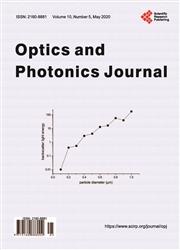Methods and Devices of Speckle-Noise Suppression (Review)
引用次数: 7
Abstract
Speckles in images formed by a laser beam are interference noise arising due to coherent nature of laser radiation. As the number of projection systems using laser light sources increases, new methods and devices appear for reducing the contrast of speckle-noise and thereby suppressing it. Taking into account the long-standing nature of the problem and the continuing relev-ance of its solution, this review discusses modern practical methods and de-vices—despecklers, used to reduce the speckle contrast and to achieve high quality of projected images. The review discusses the nature of the speckles appearance, considers their statistical properties, and describes the measurement of the speckle contrast. The requirements for despecklers are considered, the most important of which are speckle suppression efficiency, sim-plicity of design and compactness, low power consumption and low optical loss. The characteristics of different types of despecklers, including diffusers, devices based on electroactive polymers, optical waveguides, colloidal solutions and liquid crystals, as well as orthogonal phase matrices and diffraction gratings proposed as despeckers, are examined in detail. It is shown that despecklers with decorrelation of the phase front based on the mirror deformation and optical fiber have less light losses. Electro-optical-liquid crystal despecklers do not have mechanically deformable or moving elements that reduce the reliability and durability of operation, and are more compact and simple in design. A comparative table of characteristics of the most effective despecklers in which the speckle contrast is reduced to ten percent or less, with an indication of their advantages and disadvantages, is given.散斑噪声抑制方法与器件(综述)
由激光束形成的图像中的斑点是由于激光辐射的相干性而产生的干扰噪声。随着使用激光光源的投影系统数量的增加,出现了新的方法和设备来降低散斑噪声的对比度,从而抑制它。考虑到该问题的长期性质及其解决方案的持续相关性,本文讨论了用于降低斑点对比度和实现高质量投影图像的现代实用方法和设备-消斑器。本文讨论了散斑出现的性质,考虑了它们的统计特性,并描述了散斑对比度的测量方法。考虑了对消斑器的要求,其中最重要的是抑制散斑的效率、设计的简单和紧凑、低功耗和低光损耗。详细介绍了不同类型消光器的特点,包括扩散器、基于电活性聚合物的器件、光波导、胶体溶液和液晶,以及作为消光器的正交相矩阵和衍射光栅。结果表明,基于镜面变形和光纤的相位前去相关的消光器具有较小的光损失。电光液晶消光器没有机械变形或运动元件,从而降低了运行的可靠性和耐用性,设计更加紧凑和简单。最有效的消斑器的特点的比较表,其中斑点对比度降低到百分之十或更少,与他们的优点和缺点的指示,给出。
本文章由计算机程序翻译,如有差异,请以英文原文为准。
求助全文
约1分钟内获得全文
求助全文

 求助内容:
求助内容: 应助结果提醒方式:
应助结果提醒方式:


